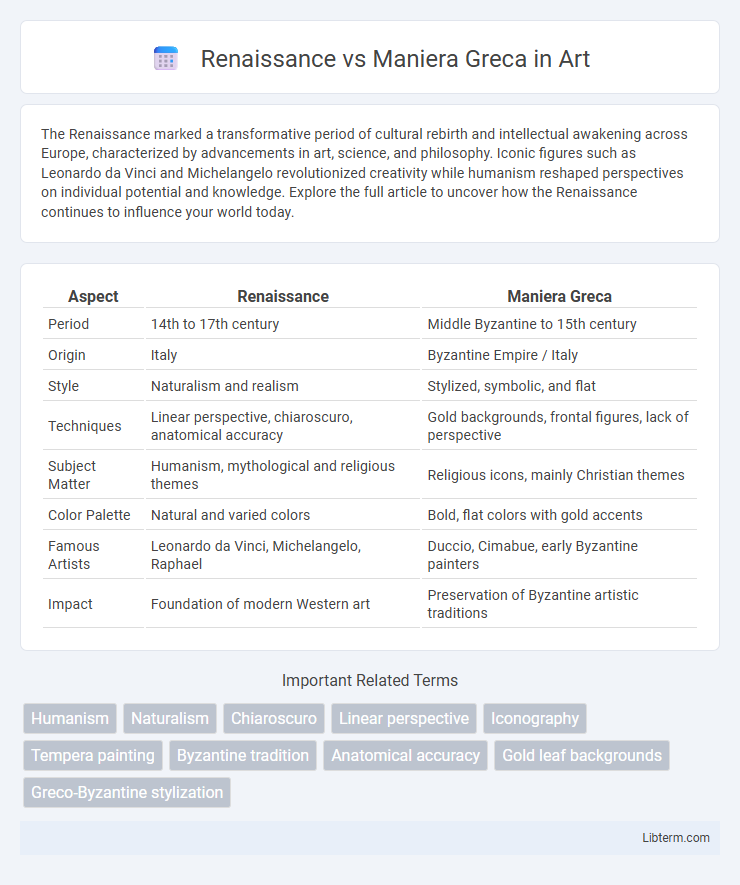The Renaissance marked a transformative period of cultural rebirth and intellectual awakening across Europe, characterized by advancements in art, science, and philosophy. Iconic figures such as Leonardo da Vinci and Michelangelo revolutionized creativity while humanism reshaped perspectives on individual potential and knowledge. Explore the full article to uncover how the Renaissance continues to influence your world today.
Table of Comparison
| Aspect | Renaissance | Maniera Greca |
|---|---|---|
| Period | 14th to 17th century | Middle Byzantine to 15th century |
| Origin | Italy | Byzantine Empire / Italy |
| Style | Naturalism and realism | Stylized, symbolic, and flat |
| Techniques | Linear perspective, chiaroscuro, anatomical accuracy | Gold backgrounds, frontal figures, lack of perspective |
| Subject Matter | Humanism, mythological and religious themes | Religious icons, mainly Christian themes |
| Color Palette | Natural and varied colors | Bold, flat colors with gold accents |
| Famous Artists | Leonardo da Vinci, Michelangelo, Raphael | Duccio, Cimabue, early Byzantine painters |
| Impact | Foundation of modern Western art | Preservation of Byzantine artistic traditions |
Introduction to Renaissance and Maniera Greca
Renaissance art, emerging in 14th-century Italy, emphasized naturalism, perspective, and classical themes, marking a departure from the stylized forms of earlier periods. Maniera Greca, prevalent during the Byzantine era, is characterized by its iconic, flat, and symbolic representations with gold backgrounds and rigid figures. The transition from Maniera Greca to Renaissance art signifies a shift towards realism, human emotion, and scientific observation in artistic expression.
Historical Context and Origins
The Renaissance style emerged in 14th-century Italy, reflecting a revival of classical antiquity and humanism with a focus on naturalism and perspective. Maniera Greca, or "Greek manner," originated in Byzantine art traditions and dominated Italian religious painting before the Renaissance, characterized by stylized figures and gold backgrounds. The transition from Maniera Greca to Renaissance art marked a shift from symbolic representation to realistic spatial depth and anatomy informed by the rediscovery of ancient Roman and Greek art.
Key Characteristics of Maniera Greca
Maniera Greca is characterized by its use of gold backgrounds, rigid figures, and a strong emphasis on religious symbolism, reflecting Byzantine artistic traditions. This style prioritizes spiritual representation over naturalism, with flat, frontal compositions and elongated faces that convey a sense of divine presence. Unlike the Renaissance focus on realism and perspective, Maniera Greca maintains a stylized, iconic approach to religious imagery.
Defining Features of the Renaissance Style
The Renaissance style emphasizes naturalism, balanced composition, and the use of perspective to create depth, distinguishing it from the flat, symbolic forms of Maniera Greca. Artists such as Leonardo da Vinci and Raphael advanced anatomical accuracy and realistic human emotion, reflecting a revived interest in classical antiquity. This approach integrates harmony, proportion, and chiaroscuro, fostering a lifelike representation that contrasts with the rigid and ornamental qualities of the Byzantine-influenced Maniera Greca.
Influential Artists: Byzantine Masters vs Renaissance Innovators
Byzantine masters such as Cimabue and Duccio epitomized the Maniera Greca style with their iconic gold backgrounds, stylized figures, and religious symbolism that emphasized spiritual representation over naturalism. Renaissance innovators like Leonardo da Vinci, Michelangelo, and Raphael revolutionized art by introducing linear perspective, anatomical accuracy, and human emotion, creating a sense of depth and realism that departed from the flatness of Byzantine aesthetics. The contrast between these artists highlights a critical shift from the rigid, symbolic forms of Byzantine art to the dynamic, human-centered approach of Renaissance painting.
Techniques and Materials: Traditional vs Innovative Approaches
Renaissance art embraced naturalism through techniques like linear perspective, chiaroscuro, and oil painting, utilizing innovative materials such as canvas and pigment blending to achieve depth and realism. In contrast, Maniera Greca maintained traditional methods with gold leaf backgrounds, tempera on wood panels, and stylized, flattened figures rooted in Byzantine iconography. While Renaissance artists experimented with light, anatomy, and spatial accuracy, Maniera Greca prioritized symbolic representation and spiritual clarity through time-honored techniques.
Religious Iconography and Symbolism
The Renaissance style in religious iconography emphasized naturalism, human emotion, and spatial depth, reflecting a revival of classical ideals and realistic portrayal of biblical figures. Maniera Greca, rooted in Byzantine tradition, maintained a more symbolic and stylized approach with flat, gold backgrounds and elongated figures, emphasizing divine spirituality over earthly realism. These contrasting artistic methods reveal differing theological priorities: Renaissance art aimed to humanize sacred subjects, while Maniera Greca preserved transcendent, otherworldly symbolism.
Humanism and the Evolution of Artistic Focus
Renaissance art emphasized humanism by portraying realistic human anatomy, emotion, and scientific perspective, marking a shift from the flat, symbolic style of Maniera Greca. This evolution prioritized the study of nature and classical antiquity, fostering a deeper exploration of individuality and spatial depth in artworks. As a result, Renaissance artists moved away from the rigid, gold-background icons typical of Maniera Greca toward more naturalistic and human-centered representations.
Impact on European Art and Cultural Legacy
The Renaissance marked a profound transformation in European art by emphasizing naturalism, perspective, and classical themes, leading to a cultural rebirth that shaped Western aesthetics and intellectual thought. In contrast, the Maniera Greca, rooted in Byzantine traditions, preserved iconic religious symbolism and stylized forms, influencing Eastern Orthodox art and maintaining a distinct spiritual heritage. Both styles collectively enriched European cultural legacy by blending innovation with tradition, fostering diverse artistic expressions across regions and eras.
Conclusion: Lasting Influence and Differentiation
Renaissance art, marked by naturalism, perspective, and human emotion, revolutionized Western aesthetics and laid the foundation for modern artistic practices. In contrast, Maniera Greca maintained the Byzantine tradition with its iconic, stylized forms and spiritual symbolism, influencing Eastern Orthodox art for centuries. The enduring legacy of Renaissance art is its emphasis on realism and individualism, while Maniera Greca's impact persists through its devotional intensity and timeless iconographic conventions.
Renaissance Infographic

 libterm.com
libterm.com